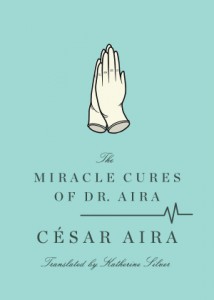Book Review: César Aira’s Miraculous Conception
In an age where technology has made the improbable perfectly plausible, squeezed out spontaneity, and raised skepticism about the nature of reality, how can we still believe in miracles? This is the crux of the novel, made delightfully vivid and comic by César Aira’s prose.
The Miracle Cures of Dr. Aira by César Aira. Translated by Katherine Silver. New Directions, 88 pages, $12.95.
By Kevin Hong
In today’s world, fiction and reality have converged. Reality television purports a documentary-like perspective, but behind the scenes, it is carefully manicured: directors plant rivalries and love interests when they do not organically arise, editors cobble together quotations to create a sentiment that was previously not there. During televised awards nights, “sitters” stand discreetly in the aisles during the show; when a celebrity stands to receive an award, the sitter quickly deposits him or herself in that person’s spot. When the camera pans over the smiling, applauding audience, the house looks full—we don’t notice that one face has been exchanged for another.
We make a sport of this convergence, or collision. The show Punk’d, for example, brings practical jokes to another level; high production costs and advanced technology allow pranksters to perpetrate more elaborate and realistic tricks than ever before. We laugh at the show’s victims because we can see that fiction has successfully masqueraded as reality. This masquerade has been going on since the beginning of “modernity”: in the 1890s, the trompe l’oeil painters placed their works—depictions of letter racks, violins, game, currency—in saloons and department stores. Unsuspecting victims would reach out to touch an old brass horn and then recoil when their fingers touched canvas.
Dr. Aira, in César Aira’s novel The Miracle Cures of Dr. Aira, finds himself in this double-bind. A miracle doctor, Aira is constantly harassed by Dr. Actyn, who wishes to prove that Aira is a quack. In part one of the book, Actyn stages a scene in which an ambulance approaches Aira and a doctor asks him to cure a dying patient. Hidden cameras among the IVs and computer screens are poised to capture Aira’s failure. But Dr. Aira intuits this and refuses to perform a miracle; to work his magic would be to risk a blunder, and blundering would cause the world to believe Actyn’s false accusations. The fake patient dies. “‘Jackass,’” he mutters, as Dr. Aira steps out of the vehicle.
The miracle doctor lives in a “minefield” of these little dramas. César Aira writes, “Escaping from one trap didn’t mean anything, because his enemy was so stubborn he would set another one; one performance sprung from another; he was living in an unreal world.” In order to prove that Dr. Aira’s profession is a fiction, Actyn creates a continuous theater, one that puts Aira’s “mental world” at risk. Realism, as exemplified by Dr. Actyn, is merely a stylized mode of representation; it welcomes spontaneity and improbability, which heighten its effect. (It is this “deviation from the reasonable” that makes any story more plausible.) Thus, fiction writers intentionally plot obstacles. It is this unnatural unpredictability that helps generate the aura of realism.
The tyranny of realism has produced the predicament that Dr. Aira and all of us face. Just as we fall deeper into the fiction that builds around us, we monitor ourselves, wary of every misstep, every doubt. Our heightened self-awareness, self-reflexivity, has removed spontaneity from our lives. We have become hyper-sensitive and super-skeptical while we remain ever gullible.
Better to retreat into solitude and avoid these embarrassments, “private disgraces”—which, in today’s world, are seldom private. “They happen to everybody,” César Aira writes. “They are the inevitable result of sociability, and the only solution is to forget.” Dr. Aira subscribes to this philosophy. In fact, although he calls himself a miracle doctor, he has never performed a miracle cure: “Like so many other phenomena in our era dominated by media fiction, his fame had preceded him. His own myth surrounded him, and the myth’s mechanism had continually delayed him from going into action, until there came a point when doing so had become inconceivable.” Aira welcomes this free pass. It saves him from potential awkwardness, “cessations of time” that would “[leave] a scar on the eminently smooth skin of his ideal behavior.” One is perfect when one does not attempt action. The doctor’s profession, then, is a profession in the most literal sense: a declaration of belief.
In an age where technology has made the improbable perfectly plausible, eliminated spontaneity, and raised skepticism about the nature of reality, how can we still believe in miracles? This is the crux of the novel, made delightfully vivid and comic by Aira’s prose. (Katherine Silver’s translation, I should note, is seamless, clearly rendered. I can only imagine how difficult it must be to thread through this metafiction, which she does deftly and elegantly.) Aira, coming from the strong, Latin American tradition of magical realism, recognizes and perhaps mourns the passing of that style, in which miracles are accepted as part of the everyday. He writes of a live, headless dog born in the countryside:
Under other circumstances the fact that such a monster was viable would have attracted the attention of scientists all around the world; it should have been considered a kind of miracle. But country folks are accustomed to such miracles—paradoxically, they used to be more accustomed to them, back then when they lived in greater isolation, without radio or television or magazines; their entire world was the small world they lived in, and their laws made room for exceptions and extensions, as a totality always does.
Our world is caught up in the totality of realism. While it leaves room for strategic flickers of spontaneity and for improbability, it excludes the supernatural, anything that is not “true reality.” In order to believe in miracles, and furthermore to produce one, a whole other totality must be created. This is Dr. Aira’s monumental task when he is finally called upon to perform a miracle cure. It’s quite theoretical, and the semantic dancing that Aira does is quick and complex. Let me note that Aira’s process, as César Aira himself describes, is like the writing of a novel. The novel, to the author is “an antecedent of Miracles, precisely because the events the novel recounts can happen as a result of what it excludes.” To write a novel is to create a totality with its own laws of motion. And if it is a masterpiece, “it takes on the weight of reality as well.”
The ultimate question, begot by the collision of fiction and reality, is answered by Aira’s separation of the two. He returns to fundamentals: fiction does not conform to or meld with reality, but it is an act of creation, a new thing entirely. “Fiction” comes from the Latin fingere, meaning “form, contrive”; to make a fiction is to make another universe. In Aira’s words, it is “an extreme case of ‘doing something with words.’” In essence, Dr. Aira performs his miracle by creating an elaborate fiction. It is the triumph of thought over reality, a masterpiece so complete that it approaches the supernatural. Aira’s originality comes from his postulation that man can emulate God’s power. “In the beginning, there was the Word”: to Aira, words are the beginning of all existence. To perform a miracle is “as easy (and as difficult) as creating an artistic masterpiece.”
Of course, César Aira does not expect us to believe in the supernatural. This is, after all, a piece of fiction. Rather, his philosophical heavy lifting raises the novel to miracle status. Furthermore, to immerse oneself in the world of the masterpiece is a miracle; to believe is a miracle in itself. In a world in which anything is possible except the impossible, the act of creation continually opens up new worlds of possibility.



Cesar Aira is totally awesome.